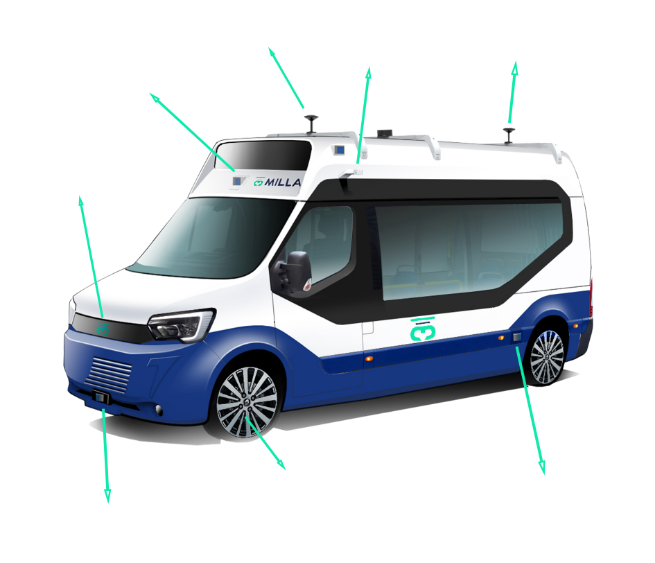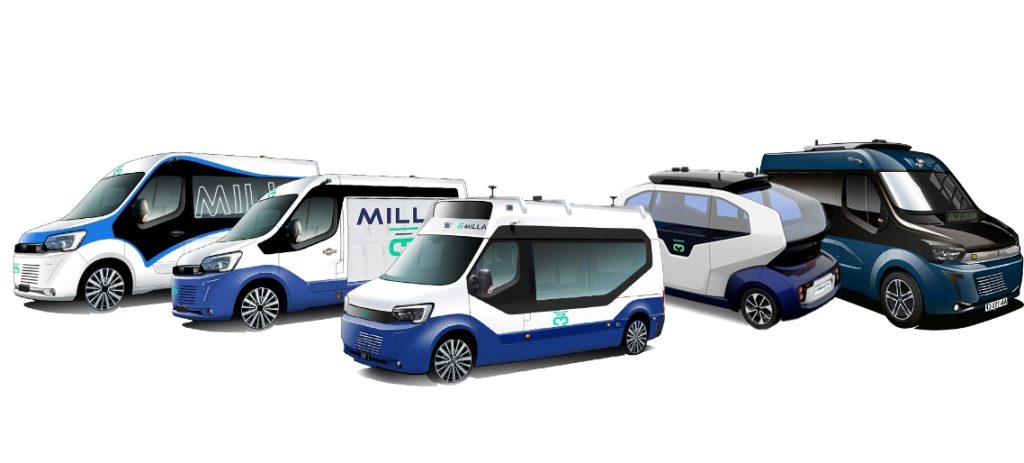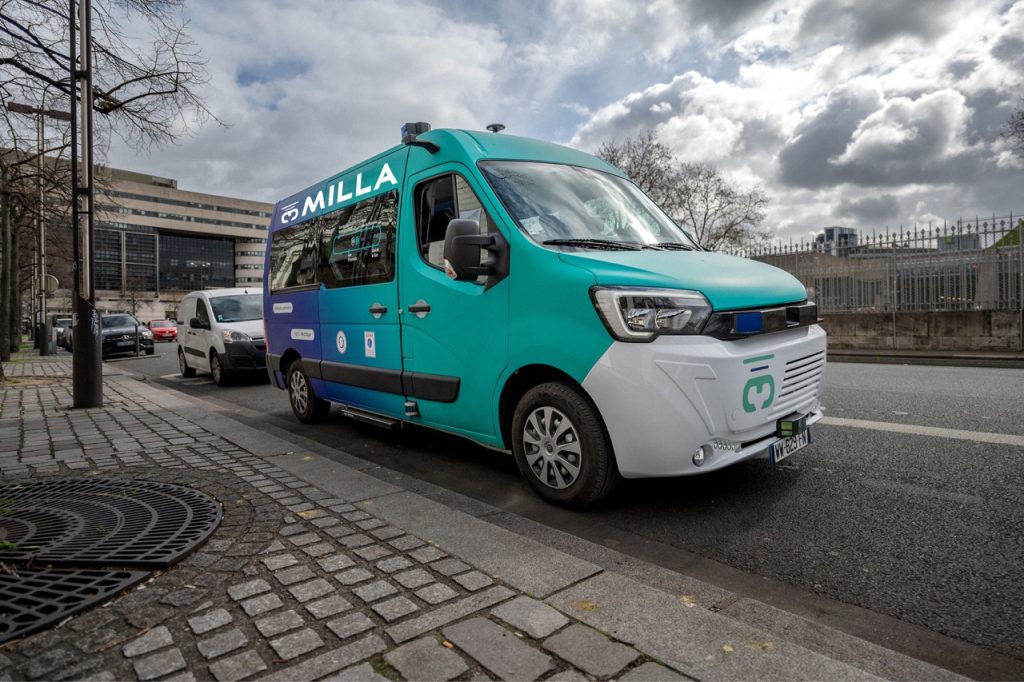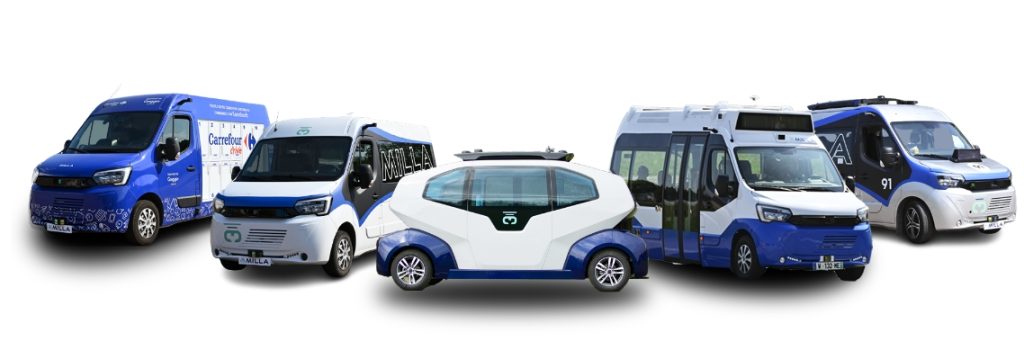What is an autonomous vehicle?
Autonomous shuttles are special vehicles equipped with advanced technologies that enable them to travel without a human driver on board. They use a range of sensors, such as cameras, radar and lidar, to detect and understand their environment.
These sensors act like the shuttle’s eyes and ears, enabling it to perceive obstacles, other vehicles, pedestrians and traffic signals. Using this information, the shuttle makes decisions in real time to navigate the road safely.
The autonomous shuttle also uses sophisticated programmes called algorithms, which analyse the sensor data and make intelligent decisions to guide the vehicle.
Another important feature of autonomous shuttles is their ability to connect to a central management and control system. This makes it possible to monitor and supervise the shuttles remotely, send software updates and collect data to continually improve system performance.

The different levels of autonomy
Current and future models of autonomous vehicles are classified into different categories according to the levels of automation defined by the SAE (formerly the Society of Automotive Engineers). These levels range from 0 to 5, from fully human to fully autonomous driving. Levels 0, 1 and 2 are not really autonomous driving. These automated functions are more akin to more or less complete driving aids. It is from level 3 onwards that vehicles begin to drive without human intervention.
The shuttle offered by MILLA is classified as level 4 automation. This means that it is capable of operating autonomously within a predefined area, without the need for constant human intervention. It offers extensive coverage, making journeys in this specific area highly efficient and optimised.
In this way, our autonomous shuttle can offer flexible transport solutions tailored to the needs of our customers, enabling them to benefit from a high-quality service, optimised journeys and more efficient use of resources.
Conditional automation
The vehicle is autonomous in a specific geographical area, but human action is required in the event of problems.
High
automation
The shuttle is fully autonomous in a specific geographical area
High
automation
Fully autonomous driving in any situation, anywhere
It is important to note that most car manufacturers are currently at level 2 or 3 of automation, according to the SAE classification.
Until last year, it was necessary for a safety operator to remain on board the autonomous shuttle to monitor its smooth operation and intervene if necessary. In France and other countries, since 2022, driverless driving has been permitted, meaning that safety operators are no longer required in all cases.
This reflects the growing confidence in the capabilities of autonomous vehicles and the progress made in terms of safety. Manufacturers and operators of autonomous shuttles like MILLA are working closely with authorities and regulators to ensure that these vehicles meet the highest standards of safety and reliability.
We are proud to be part of this evolution and to offer autonomous shuttles that combine performance, safety and efficiency to provide an innovative and uncompromising transport experience for our customers.
These regulatory developments open up new perspectives for the deployment and use of autonomous vehicles, offering opportunities to improve mobility, road safety and transport efficiency. At MILLA, we are at the forefront of this innovation and our advanced solutions meet the current and future needs of our customers.
Possible applications for shared and on-demand autonomous transport
At MILLA, we are proud to offer automation solutions in two key areas: person transport and freight transport.
When it comes to person transport, our autonomous shuttles offer a modern, flexible alternative to private cars. Whether it’s for commuting, urban travel or shuttle services in enclosed areas such as university campuses or industrial parks, our vehicles guarantee a safe, comfortable and environmentally friendly journey.
Transport of person
When it comes to person transport, our autonomous shuttles offer a modern, flexible alternative to private cars. Whether it’s for commuting, urban travel or shuttle services in enclosed areas such as university campuses or industrial parks, our vehicles guarantee a safe, comfortable and environmentally friendly journey.
Transport of freight
When it comes to goods transport, our solutions meet the specific needs of companies for last-mile and penultimate-mile deliveries. We help our customers to optimise their logistics operations by offering autonomous vehicles adapted to enclosed urban and suburban areas, enabling zero-emission deliveries, thereby reducing environmental impact while ensuring greater operational efficiency.

Thanks to our expertise and industrial approach, we can provide reliable, cost-effective solutions, opening up new horizons for the transport of people and goods.
The advantages of autonomous transport
Our autonomous transport solutions offer many advantages, whether for transporting people or goods:
Effectiveness
Sustainability
Flexibility
Safety
Cost reduction
In short, the advantages of our autonomous transport solutions lie in their efficiency, sustainability, flexibility, safety and positive economic impact, offering a new era of mobility for people and goods.
Key technologies for autonomous shared and on-demand transport
The MILLA autonomous shuttle is not just a vehicle, it is an integrated system comprising the vehicle itself, its remote monitoring and the connected infrastructure.
At MILLA GROUP, the safety of our shuttles is a major issue. That’s why we use a wide range of sensors that comply with automotive standards to ensure greater reliability. As a result, we use a wide variety of sensors.
To map their environment at MILLA we have chosen to use lidar. These are sensors that project invisible laser beams to detect obstacles. Thanks to them, our shuttles know exactly where other vehicles, urban structures and pedestrians are.
Used as a complement to the lidar range, MILLA shuttles feature cameras that are very important for both the supervisor and the shuttle. Using lidar data and recognition algorithms, the video streams are analysed to determine the nature of each obstacle and to treat them in a specific way. The video streams are also visible to the remote supervisor.
Automated vehicles like MILLA’s also have odometric sensors. This on-board sensor is placed on the wheels of a vehicle to measure its speed and movements accurately and reliably.
This non-exhaustive list of sensors enables the shuttles’ environment to be analysed in real time for 100% autonomous and safe driving.
Until last year, it was necessary for a safety operator to remain on board the autonomous shuttle to monitor its smooth operation and intervene if necessary. In France and other countries, since 2022, driverless driving has been permitted, meaning that safety operators are no longer required in all cases.
This reflects the growing confidence in the capabilities of autonomous vehicles and the progress made in terms of safety. Manufacturers and operators of autonomous shuttles like MILLA are working closely with authorities and regulators to ensure that these vehicles meet the highest standards of safety and reliability.
We are proud to be part of this evolution and to offer autonomous shuttles that combine performance, safety and efficiency to provide an innovative and uncompromising transport experience for our customers.
These regulatory developments open up new perspectives for the deployment and use of autonomous vehicles, offering opportunities to improve mobility, road safety and transport efficiency. At MILLA, we are at the forefront of this innovation and our advanced solutions meet the current and future needs of our customers.
The MILLA autonomous shuttle is not just a vehicle, it is an integrated system comprising the vehicle itself, its remote monitoring and the connected infrastructure. Known as V2X (vehicle to everything) functionalities, together they form a communication protocol between urban and road infrastructures, the cloud and connected vehicles.
Intelligent vehicles like our shuttles can communicate with the cloud to export data from their various sensors. This data is invaluable to the supervisor. It is also possible to use V2X technology with connected traffic lights to tell the shuttle its status. This is not compulsory, but it enables the shuttles to anticipate the status of a traffic light before it is changed.
V2X also relies on information from nearby vehicles. Thanks to the low latency of 5G, this technology opens up new prospects for improving the perception of the environment of autonomous shuttles…
Together, these elements offer an advanced mobility solution that is sustainable and accessible to all. The entire transport system is monitored and controlled in real time.
It is important to note that most car manufacturers are currently at level 2 or 3 of automation, according to the SAE classification.
Until last year, it was necessary for a safety operator to remain on board the autonomous shuttle to monitor its smooth operation and intervene if necessary. In France and other countries, since 2022, driverless driving has been permitted, meaning that safety operators are no longer required in all cases.
This reflects the growing confidence in the capabilities of autonomous vehicles and the progress made in terms of safety. Manufacturers and operators of autonomous shuttles like MILLA are working closely with authorities and regulators to ensure that these vehicles meet the highest standards of safety and reliability.
We are proud to be part of this evolution and to offer autonomous shuttles that combine performance, safety and efficiency to provide an innovative and uncompromising transport experience for our customers.
These regulatory developments open up new perspectives for the deployment and use of autonomous vehicles, offering opportunities to improve mobility, road safety and transport efficiency. At MILLA, we are at the forefront of this innovation and our advanced solutions meet the current and future needs of our customers.
How does setting up an autonomous mobility service work?
Our shuttles are classified at automation level 4, which means they are able to operate autonomously in a specific operating area, and not limited to a predefined path. Setting up a service using a vehicle with this degree of automation requires an additional preparation phase.
Establishing an autonomous shuttle service is similar to setting up a guided transport system such as a tram, RER or train. Like any service of this type, autonomous shuttles require a preliminary phase.
This implementation period varies depending on the complexity of the area, but in general it extends over a period of 2 weeks to 2 months.

Here are the main steps
We map the area accurately using our vehicles and work on this map to optimize the routes and navigation of autonomous shuttles.
We perform several days of intensive driving with the shuttles to adjust their operation and ensure optimal performance.
As with all guided services, we carry out a phase without passengers on board the shuttles. This allows us to validate all operational aspects and ensure the system is ready for users.
Once all the previous steps have been validated, the autonomous shuttle service can be opened to the general public. Passengers can then enjoy convenient, reliable and secure transportation.
This ensures that the autonomous shuttle service works optimally and meets the expectations of users. We ensure that every step is carefully carried out to ensure a smooth and enjoyable travel experience for all.
Case studies
Since its creation, MILLA GROUP has developed and deployed many automated transport services across France. Our autonomous shuttle solutions are designed to solve major problems facing our societies, whether at the economic, societal or environmental level. Whether it is to open up rural areas, improve access to transport in peri-urban areas or reduce the carbon footprint in urban areas, our shuttles adapt to their environment and meet the specific requirements of each context. We bring our expertise to mobility solutions that help shape a sustainable and inclusive future for all.
Cœur de Brenne : https://www.
La Rochelle : https://www.agglo-larochelle.
Questions about autonomous transport of people?
The safety of MILLA shuttles is based on an approved vehicle base, which is our most essential point. We have developed a deterministic system that offers maximum reliability, complemented by a judicious use of artificial intelligence.
Our autonomous shuttles are equipped with components and sensors from the automotive world, renowned for their quality and reliability. These elements are carefully selected and integrated to ensure optimal operation of our shuttles.
Thanks to our expertise in the automotive and digital fields, we cover the entire value chain of autonomous shuttles. From design to manufacturing and system integration, we strive to provide complete and efficient solutions.
We offer our customers a secure and proven autonomous transport solution, based on approved vehicles and advanced technologies. Passenger safety and the reliability of our services are at the heart of our concerns, and we are committed to maintaining the highest standards of safety in all our operations.
Autonomous transport has a significant impact on the economy and employment in the transport sector. irst, it offers opportunities for innovation and economic growth. Companies that develop and deploy autonomous transportation solutions contribute to the creation of new technologies, new jobs and new industries.
In terms of employment, autonomous transport creates new job prospects. It requires specific skills in the fields of technology, artificial intelligence, data management, supervision and maintenance of autonomous vehicles. Thus, new jobs are created in these expanding fields.
On the other hand, autonomous transport can also generate positive effects on the economy by reducing transport costs and improving the efficiency of operations. Autonomous vehicles can be programmed to optimize trips, reduce fuel consumption and minimize wait times, resulting in savings for businesses and consumers.
Autonomous transport can contribute to the reduction of road accidents, which has a positive impact on accident-related costs, such as health expenses and productivity losses.
Moreover, employment integration is a crucial issue in our society. According to studies by the Inclusive Mobility Laboratory, nearly 19% of job seekers have had to give up maintenance due to lack of adequate transport. At MILLA, we are actively committed to solving this problem by offering inclusive and accessible autonomous transportation solutions. Thanks to our autonomous shuttles, we help break down mobility barriers that can prevent some people from accessing employment. By providing a reliable, affordable means of transportation that is tailored to everyone’s needs, we help job seekers overcome travel constraints and actively participate in the recruitment process.
We see autonomous shuttles as an essential complement to existing modes of transport. Our goal is not to replace buses and other means of public transport, but rather to offer an alternative solution to individual vehicles.
Autonomous transportation offers a convenient, environmentally friendly and economical transportation option for daily commuting. By offering an automated service, we aim to reduce dependence on individual cars and contribute to more sustainable mobility.
In summary, autonomous transportation has the potential to stimulate the economy, create new jobs and improve transportation efficiency and safety. It represents a major opportunity for positive transformation for the transport sector and the economy in its entirety.
The legal framework for autonomous vehicles is rapidly evolving to support technological advances. In France, since 2022, driverless driving has been allowed on board, which opens new perspectives for the deployment of autonomous shuttles. Autonomous vehicles are classified into different levels of automation, ranging from level 0 to level 5, defined by organizations such as the SAE. Currently, most automakers are at level 2 or 3, with human presence required for vehicle supervision. However, MILLA’s autonomous shuttles are Level 4, which means that they are able to operate autonomously in a defined operating area, without requiring the intervention of a driver. These technological advances are supported by stringent regulations and safety standards, aimed at ensuring the safety and reliability of autonomous vehicles on the roads.
Autonomous transport can play a key role in reducing the environmental footprint of transport. First, autonomous shuttles promote shared transportation, which reduces the number of individual vehicles on the road. This helps reduce greenhouse gas emissions, air pollution and traffic congestion. In addition, MILLA’s autonomous shuttles are 100% electric or use clean technologies such as hydrogen, which makes them not only zero emissions, but also more environmentally friendly. By optimizing journeys and avoiding traffic jams thanks to their onboard intelligence, autonomous shuttles also reduce energy consumption and polluting emissions. Finally, by offering a practical and sustainable alternative to individual vehicles, autonomous transport encourages a transition towards more sustainable mobility, thus contributing to the preservation of the environment and the fight against climate change.
